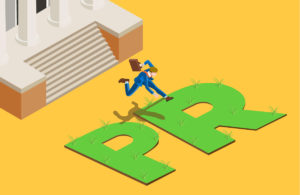Recently, I was perusing the public relations Reddit page (as all PR nerds do) and noticed a trend. There was an influx of posts from those looking to make a transition from their current career into PR. From a vet tech to a former journalist, current careers spanned the board, but many of the questions remained the same. What skills do you need to be in PR? What exactly would a day in PR look like? Isn’t PR just about media relations?
While society often expects young adults to make difficult decisions about their career paths at the age of 18, few people openly discuss how that path is often filled with questions, doubts and challenges. While some may be lucky to know exactly what they want to do from a young age, others come out of college unsure what a career in their field really looks like, which is why changes in careers among recent graduates are so common.
So, for all of those struggling to shift gears in their career path, whether you’re 21 or 41, I’ve outlined a few helpful guidelines on what PR looks like in 2018 and the skills you need to succeed.
What does PR look like in 2018?
To generalize, public relations is practiced in two environments: you can work at an agency or in corporate communications. At an agency, you may handle multiple clients at one time and work with a larger team. In corporate communications, you will be responsible for the communications and messaging of one company and may have a more compact team. Also, it is not uncommon to see a corporation with its own internal communications team pair up with an agency to supplement its work.
Public relations has gone through a variety of changes throughout the years, with some professionals arguing that the industry has outgrown the term “public relations.” They believe “communications” better describes the broad nature of the field. Once viewed as strictly media relations, PR pros would pitch their clients’ stories and expertise to the media in the hopes of earning media placements. Today, it is much more.
While media relations is still the dominant part of the field, the reality of our 24/7 news cycle and social media age has forced public relations professionals to wear many hats. Today, a PR professional can most likely also call herself a social media expert, strategic communications planner, creative campaign designer, media relations savant, crisis communications counselor, digital strategist and video producer.
The advancement of technology has required PR experts to adopt it and use it as a tool to further a client’s narrative. In 2018, public relations is about telling a client’s story through media placements, powerful messaging and a strong digital presence across many platforms.
What skills do you need to be in PR?
Whether you work at an agency or on the corporate side, each has its own set of challenges. But the principal skills needed generally remain the same. Public relations is about finding each client’s unique story and helping them tell it in a meaningful way. For that reason, skillfulness in writing, multi-tasking, research, creativity and attention to detail (especially when it comes to grammar) is paramount.
No two days in PR are the same, which is why understanding how to manage multiple tasks at once is important. One day you might be drafting social posts and a release for a client, while on the next you might be tasked with putting together a communications plan for a new product. Time management and multi-tasking help public relations professionals address a handful of equally important projects simultaneously.
When it comes to storytelling, creativity and research are key. A PR pro is constantly shifting between the aforementioned hats they must wear, so a knack for bringing fresh and creative ideas to a variety of tasks is valuable. Whether it’s crafting taglines for a new campaign or writing a technical blog post for a client, an ability to think outside the box and do your homework is vital.
While all of these skills are important, none of these tasks can be executed properly without strong writing skills and attention to detail. Solid writing and immaculate grammar ensure you’re telling a client’s story in the most compelling way possible and putting them in the best light.
It can be scary to enter a field that is different from what you studied in college. At Buchanan, when an intern candidate comes in to interview, it is not uncommon that his or her major is something outside of the communications field, like psychology or political science. In public relations, companies are looking at key skills rather than what you majored in. If you’re seriously considering a career transition into public relations, learn how to highlight your skillset, schedule informational interviews with industry professionals to learn as much as you can and don’t be afraid to seek an apprenticeship to ease your way into a new industry. With the right skills and attitude, public relations can be a fulfilling career for anyone looking to make a transition or any student trying to explore his or her career path!